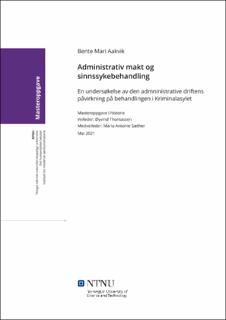| dc.contributor.advisor | Thomassen, Øyvind | |
| dc.contributor.advisor | Sæther, Maria Antonie | |
| dc.contributor.author | Aakvik, Bente Mari | |
| dc.date.accessioned | 2021-10-01T16:19:56Z | |
| dc.date.available | 2021-10-01T16:19:56Z | |
| dc.date.issued | 2021 | |
| dc.identifier | no.ntnu:inspera:80289343:22060136 | |
| dc.identifier.uri | https://hdl.handle.net/11250/2787105 | |
| dc.description.abstract | Denne masteroppgaven undersøker hvordan den administrative driften ved Kriminalasylet påvirket behandlingen pasientene mottok. Kriminalasylet ble etablert i Trondheim, og åpnet i 1895. Dette skulle bli en sikkerhetspsykiatrisk institusjon med formålet å internere og behandle sinnssyke forbrytere og forbryterske sinnssyke.
For å undersøke påvirkningen det administrative hadde på behandlingen er det gjennom oppgaven anvendt kildemateriale om og fra Kriminalasylet. Gjennom analyse av kildematerialet blir driften presentert gjennom tre ulike perspektiver: statlig, administrativt og pasientenes perspektiv. Stortingsdokumenter før asylet ble grunnlagt blir anvendt for å undersøke fagmiljøets innstilling til denne institusjonen, og hva de anså som formålet med den. Regulativet som ble utformet av Justisdepartementet la grunnlaget for hvordan driften av Kriminalasylet skulle organiseres, og er blitt undersøkt for å diskutere hvordan staten utøvde kontroll over asylet. I forbindelse med statlig påvirkning er begrepene Governmentality og Bio-politikk anvendt for å skape et rammeverk for å forstå hvordan statlig makt kunne påvirke hverdagen til pasientene og i hvilken grad. Årsberetninger og overvokterens protokollbok, også kalt vokterjournaler, utgjør hovedtyngden i kildematerialet. De er anvendt for å undersøke hvordan driften ble utført i praksis, og i hvilken grad den faktiske driften overholdt de reglene som regulativet presenterte. | |
| dc.description.abstract | In this master thesis I have discussed how administrative processes within the Norwegian asylum for the criminally insane affected the treatment the patients received. The asylum for the criminally insane was established, and opened, in Trondheim in 1895. This was an institution whose main goal was to confine and treat the criminally insane in Norway.
I have used a variety of sources to discuss how these administrative processes affected the treatment. Most of these sources were created in or about the asylum. The analysis of this source material is presented through three perspectives: a state-, administrative- and patient perspective. Government documents concerning the founding of the asylum is used to understand what the experts at the time thought of the proposition to create an asylum for this particular group of patients, and what the main goal of such an institution should be. The Justice department created a set of rules for the running of the asylum. These rules have been examined in order to view how the state controlled the asylum. In relation to this examination the terms Governmentality and Bio-politics have been used to create a framework to understand how state power affected the patient’s everyday life and to what degree. The asylum´s annual reports and the head of the guard´s book of protocols, also called the guards journal, make up the majority of the source material. This material has been used to discuss the practical execution of the rules and regulations created by the state, and to discuss whether or not these rules were followed. | |
| dc.language | nob | |
| dc.publisher | NTNU | |
| dc.title | Administrativ makt og sinnssykebehandling - En undersøkelse av den admninistrative driftens påvirkning på behandlingen i Kriminalasylet | |
| dc.type | Master thesis | |
